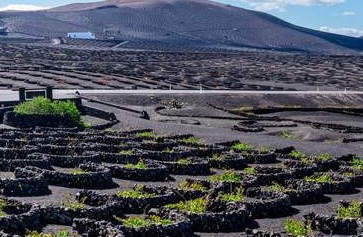
Friday read: Lanzarote’s battle to protect tradition
Following the launch of Jable de Tao’s first artisanal wines, Barnaby Eales charts the progress being made to protect the hoyos-grown vine legacy of La Geria, asking if enough is being done to secure their future.
In Lanzarote’s lava fields of La Geria vines have been grown in holes of volcanic ash, known as hoyos, since the eighteenth century. But in recent years this low-yielding viticulture has, unfortunately, been replaced in some areas with the planting of higher density vines in rows of trenches (zanjas) which more than doubles yields. Sadly, Lanzarote’s vineyard area has decreased from around 3,000 ha in 2007 to 1,800 hectares hundreds of which are in La Geria, where many growers have abandoned viticulture in recent years.
That said, there’s a growing thirst for Lanzarote wines both locally and internationally. New producers are moving into a market where average grape prices per kilo have increased from €1.6 in 2018, to between €3 and €3.5 in 2023.
However, growers who supply the island’s 33 producers say that Malvasia Volcanica grape prices remain too low in relation to the production costs of hoyo viticulture.
- Read more: South Africa Wine partners with Stellenbosch University on 'pioneering' Chenin Blanc project
The building of wineries in La Geria is itself highly contentious: take for example, the lengthy high profile legal case against the construction of the Stratvs winery, built into the landscape at Barranco del Obispo with cellars underground, whose owner was eventually absolved of all charges. Restrictive planning legislation has led to wineries placing tanks in the open air, increasing their energy costs and consumption. Wineries now want a sanitation network and renewable energy infrastructure.
In a bid to preserve and protect traditional viticulture, to recognise the labour of growers and to facilitate wine production, Lanzarote island’s government, the Cabildo, unveiled a new plan for La Geria on 18 March.
This regulatory juggling act, broadly backed by wine producers and growers, could lead to the establishment of distinctively regulated production areas in La Geria, aimed at protecting traditional viticulture, whilst also implementing legislation to make planning controls less cumbersome for wineries. It would also regulate tourism to protect vineyards.
“We are pretty satisfied with the plan which shows the island’s governors are willing to protect traditional viticulture methods as well as implementing more flexible legislation to allow producers to expand winery facilities,” Victor Diaz, chairman of the Lanzarote DO wine regulatory council told Harpers.
Diaz called for the implementation of the plan to be made as soon as possible.
Subsidies for growers according to hectares farmed have increased in recent years. However, in a separate move, the Cabildo is lobbying the Canary Islands government to establish specific subsidies for growers of hoyo viticulture, a move welcomed by Jable de Tao, a producer of organic, terroir-driven artisanal wines.
Thirst for terroir
Jable de Tao is one of the new artisanal producers looking to expand it its facilities with the building of a winery.
Owned by Alexis Betancor and his wife Matuli Rodriguez, Jable de Tao last month released four distinctive and organic artisanal white wines from the 2022 vintage championing the potential of specifics sites, soils, and microclimates of several locations in Lanzarote including La Geria. The wines are made from local grape varieties and wild yeasts, and fermented and aged in concrete eggs, 500 litre barrels and foudres.
Winemaker Carmelo Peña, who presented the new wines at Simplesmente Vinho artisanal wine fair in Porto in February, is owner of producer Bien de Altura in Gran Canaria, and has previously worked for Niepoort in the Douro and Raul Perez in Bierzo. The quality of the first Jable de Tao wines shows the extent of new strides he has undertaken in low-intervention, artisanal wine production.
“Rigorous analytic controls were made each step of the way ensuring the production of precise wines,” said Peña.
“These wines reflect distinctive areas of Lanzarote to showcasing the island’s potential and why growers using traditional viticulture should be more valued and recognised for their efforts.”
David Hall, who works in production at Jable de Tao, added: “A huge amount of work goes into the low-yielding old vineyards, which can’t be mechanised. Vines grow in deep holes. We have to shovel out lava ash from holes and then carry up 20 kilo boxes of grapes during harvest.
“Competition between vines for water is intense. There’s the threat of fungal diseases; ventilation need to be ensured, but it is worthwhile as this is about preserving heritage and making quality, artisanal wines.”
Hall continued: “One objective is to make wines which exhibit parts of the island that haven’t been shown before; there are various soil types and microclimates, and this has not been taken seriously. By vinifying grapes from small areas, we are beginning to identify their specific characteristics.”
By undertaking soil analysis to further understand Lanzarote’s geology and by making organic, low-intervention wines in such adverse conditions, producers like Jable de Tao are helping to build a more sustainable future for La Geria’s feted wines.
The future
The Lanzarote DO regulatory council says a new influx of growers and producers in recent years has helped mitigate the decline of growers and vineyard area.
Bureaucratic hurdles and production costs have, however, prompted some producers and growers to operate in areas outside of La Geria, where costs are lower. Some producers also want mechanisation to be allowed in certain vineyard areas, along with vineyard fencing. And there are still fears there will be an insufficient generational renewal of the ageing population of growers.
Moreover, Lanzarote producers and growers face the challenge of rising temperatures and the presence of Calima dust storms from the Sahara Desert. Up until this Thursday, there has been no rainfall since last year.
However, the bumper crop of 2023, which yielded 3.3 million kilos of grapes, has boosted production prospects. Organic wine production is on the rise in Lanzarote and there’s a growing interest in the profiles of ‘volcanic’ wines from Atlantic Isles off the European mainland, in terms of freshness, lower alcohol, ‘minerality’ and salinity.
Faced with the challenge of climate change and competition from lower priced wine imports from the Spanish mainland, Lanzarote’s governors have some tough decisions to make to boost the potential of the production of distinctive wines in La Geria. They need to act fast to implement their plan, which, by itself, may not go far enough to safeguard the island’s viticulture heritage.









